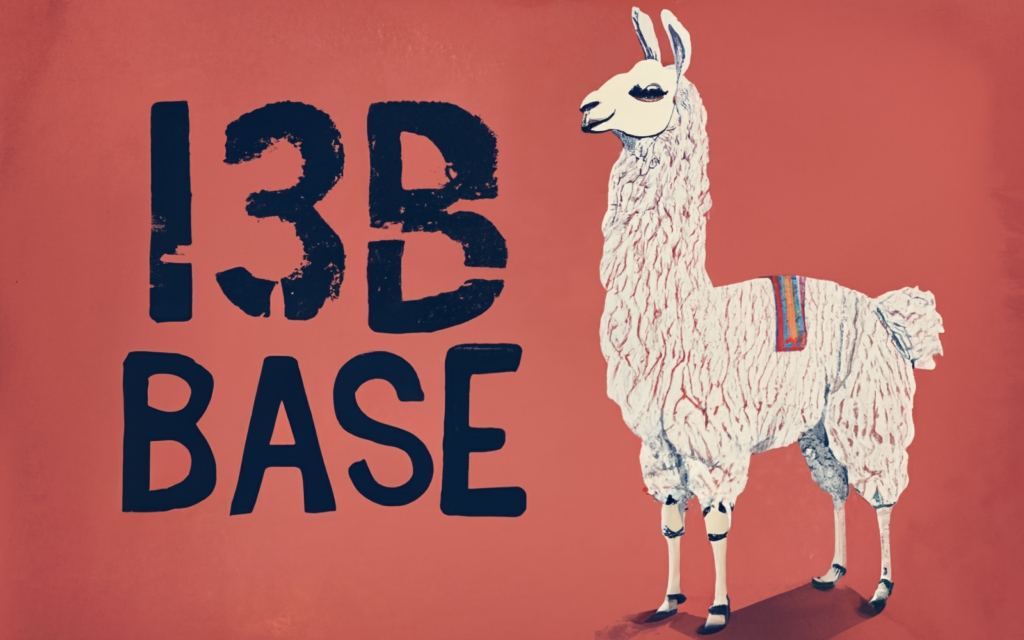llama-2-70b
Maintainer: meta

333

| Property | Value |
|---|---|
| Model Link | View on Replicate |
| API Spec | View on Replicate |
| Github Link | View on Github |
| Paper Link | View on Arxiv |
Create account to get full access
Model overview
llama-2-70b is a base version of the Llama 2 language model, a 70 billion parameter model created by Meta. It is part of a family of Llama 2 models that also includes the llama-2-7b and llama-2-7b-chat models. The Llama 3 model family, which includes the meta-llama-3-70b and meta-llama-3-8b models, are the newer generation of large language models from Meta.
Model inputs and outputs
llama-2-70b is a language model that can generate human-like text based on a given prompt. It takes a text prompt as input and produces a continuation of that prompt as output.
Inputs
- Prompt: The text prompt that the model will use to generate a continuation.
- Max new tokens: The maximum number of new tokens the model should generate.
- Min new tokens: The minimum number of new tokens the model should generate.
- Temperature: A value that controls the randomness of the output, with higher values producing more random and diverse output.
- Top k: The number of most likely tokens the model should consider when generating output.
- Top p: The cumulative probability threshold the model should use when considering tokens to include in the output.
- Stop sequences: A comma-separated list of sequences that should cause the generation to stop.
Outputs
- Generated text: The continuation of the input prompt, generated by the model.
Capabilities
llama-2-70b is a large language model that can be used for a variety of text generation tasks, such as creative writing, conversational responses, and summarization. Its large size and strong performance make it a capable model for many natural language processing applications.
What can I use it for?
You can use llama-2-70b for a variety of text generation tasks, such as:
- Creative writing: Generate fictional stories, poems, or other creative content.
- Conversational responses: Use the model to generate natural-sounding responses in a dialogue.
- Summarization: Condense long passages of text into concise summaries.
- Content generation: Create articles, blog posts, or other written content.
The model's size and capabilities make it a powerful tool for a wide range of language-based applications. As with any large language model, it's important to carefully consider the ethical implications and potential misuses of the technology.
Things to try
Some interesting things to try with llama-2-70b include:
- Experiment with different prompts and settings to see how the model's output changes.
- Use the model to generate creative ideas or story plots that you can then develop further.
- Explore the model's ability to summarize long passages of text or generate concise responses to open-ended questions.
- Investigate how the model's output varies when you change the temperature, top k, or top p settings.
Remember to use the model responsibly and consider the potential ethical implications of your experiments.
This summary was produced with help from an AI and may contain inaccuracies - check out the links to read the original source documents!
Related Models

llama-2-13b

186
The llama-2-13b is a base version of the Llama 2 language model from Meta, containing 13 billion parameters. It is part of a family of Llama models that also includes the llama-2-7b, llama-2-70b, and llama-2-13b-chat models, each with different parameter sizes and specializations. Model inputs and outputs The llama-2-13b model takes in a text prompt as input and generates new text in response. The model can be used for a variety of natural language tasks, such as text generation, question answering, and language translation. Inputs Prompt**: The text prompt that the model will use to generate new text. Outputs Generated Text**: The text generated by the model in response to the input prompt. Capabilities The llama-2-13b model is capable of generating coherent and contextually relevant text on a wide range of topics. It can be used for tasks like creative writing, summarization, and even code generation. However, like other language models, it may sometimes produce biased or factually incorrect outputs. What can I use it for? The llama-2-13b model could be used in a variety of applications, such as chatbots, content creation tools, or language learning applications. Its versatility and strong performance make it a useful tool for developers and researchers working on natural language processing projects. Things to try Some interesting things to try with the llama-2-13b model include: Experimenting with different prompts and prompt engineering techniques to see how the model responds. Evaluating the model's performance on specific tasks, such as summarization or question answering, to understand its strengths and limitations. Exploring the model's ability to generate coherent and creative text across a range of genres and topics.
Updated Invalid Date

llama-2-7b

629
The llama-2-7b is a 7 billion parameter language model developed by Meta, the base version of their Llama 2 model series. It is a smaller variant of the larger meta-llama-3-70b and meta-llama-3-8b models, offering a more compact yet capable language understanding and generation system. The llama-2-7b can be further fine-tuned for specific tasks, as seen in the codellama-70b-instruct, codellama-7b, and codellama-7b-instruct variants, which are optimized for coding and conversational tasks. Model inputs and outputs The llama-2-7b model accepts a text prompt as input and generates a sequence of text as output. The key input parameters include the prompt, temperature (to control randomness), top-p (to control diversity), and max/min tokens to generate. The output is a list of generated text tokens. Inputs Prompt**: The input text prompt to generate from Temperature**: Adjusts the randomness of the output, with higher values being more random Top P**: Samples from the top percentage of most likely tokens during generation Max New Tokens**: The maximum number of tokens to generate Min New Tokens**: The minimum number of tokens to generate (or -1 to disable) Stop Sequences**: A comma-separated list of sequences to stop generation at Outputs Generated Text**: A list of generated text tokens Capabilities The llama-2-7b model has a wide range of natural language understanding and generation capabilities, making it useful for tasks such as text summarization, language translation, question answering, and more. It can be used to generate coherent and contextually relevant text, while also exhibiting some degree of reasoning and logic. What can I use it for? The llama-2-7b model can be used for a variety of applications, including content creation, chatbots, language modeling, and even code generation when fine-tuned. For example, you could use it to generate creative writing, product descriptions, or social media posts. It could also be integrated into customer service chatbots or virtual assistants to provide more natural and engaging interactions. Things to try One interesting aspect of the llama-2-7b model is its ability to adapt to different styles and tones of writing. You could experiment with providing prompts in different voices, such as formal, casual, or even playful, and observe how the model responds. Additionally, you could try providing prompts with specific constraints, such as a certain length or topic, to see how the model handles those challenges.
Updated Invalid Date

llama-2-70b-chat

7.3K
llama-2-70b-chat is a 70 billion parameter language model from Meta, fine-tuned for chat completions. It is part of the LLaMA family of models, which also includes the base llama-2-70b model, as well as smaller 7B and 13B versions with and without chat fine-tuning. The meta-llama-3-70b-instruct and meta-llama-3-8b-instruct models are later iterations that also include instruction-following fine-tuning. Model inputs and outputs llama-2-70b-chat takes a text prompt as input and generates a text completion as output. The model is designed to engage in natural conversations, so the prompts and outputs are more conversational in nature compared to the base LLaMA model. Inputs Prompt**: The initial text prompt to start the conversation. System Prompt**: A system-level prompt that helps guide the model's behavior and tone. Additional parameters**: The model also accepts various parameters to control things like temperature, top-k/top-p sampling, and stopping conditions. Outputs Text Completion**: The model's generated response to the input prompt. Capabilities llama-2-70b-chat is capable of engaging in open-ended conversations on a wide range of topics. It can understand context, ask clarifying questions, and provide thoughtful and coherent responses. The model's large size and chat-focused fine-tuning allow it to generate more natural and engaging dialogue compared to the base LLaMA model. What can I use it for? llama-2-70b-chat could be useful for building conversational AI assistants, chatbots, or interactive storytelling applications. Its ability to maintain context and carry on natural conversations makes it well-suited for tasks like customer service, virtual companionship, or creative writing assistance. Developers may also find it helpful for prototyping and experimenting with conversational AI. Things to try Try providing the model with open-ended prompts that invite a back-and-forth conversation, such as "Tell me about your day" or "What do you think about [current event]?" Observe how the model responds and adjusts its tone and personality based on the context. You can also experiment with different temperature and sampling settings to see how they affect the creativity and coherence of the model's outputs.
Updated Invalid Date

llama-2-7b-chat

8.3K
llama-2-7b-chat is a 7 billion parameter language model from Meta, fine-tuned for chat completions. It is part of the LLaMA language model family, which also includes the meta-llama-3-70b-instruct, meta-llama-3-8b-instruct, llama-2-7b, codellama-7b, and codellama-70b-instruct models. These models are developed and maintained by Meta. Model inputs and outputs llama-2-7b-chat takes in a prompt as input and generates text in response. The model is designed to engage in open-ended dialogue and chat, building on the prompt to produce coherent and contextually relevant outputs. Inputs Prompt**: The initial text provided to the model to start the conversation. System Prompt**: An optional prompt that sets the overall tone and persona for the model's responses. Max New Tokens**: The maximum number of new tokens the model will generate in response. Min New Tokens**: The minimum number of new tokens the model will generate in response. Temperature**: A parameter that controls the randomness of the model's outputs, with higher temperatures leading to more diverse and exploratory responses. Top K**: The number of most likely tokens the model will consider when generating text. Top P**: The percentage of most likely tokens the model will consider when generating text. Repetition Penalty**: A parameter that controls how repetitive the model's outputs can be. Outputs Generated Text**: The model's response to the input prompt, which can be used to continue the conversation or provide information. Capabilities llama-2-7b-chat is designed to engage in open-ended dialogue and chat, drawing on its broad language understanding capabilities to produce coherent and contextually relevant responses. It can be used for tasks such as customer service, creative writing, task planning, and general conversation. What can I use it for? llama-2-7b-chat can be used for a variety of applications that require natural language processing and generation, such as: Customer service**: The model can be used to automate customer support and answer common questions. Content generation**: The model can be used to generate text for blog posts, social media updates, and other creative writing tasks. Task planning**: The model can be used to assist with task planning and decision-making. General conversation**: The model can be used to engage in open-ended conversation on a wide range of topics. Things to try When using llama-2-7b-chat, you can experiment with different prompts and parameters to see how the model responds. Try providing the model with prompts that require reasoning, creativity, or task-oriented outputs, and observe how the model adapts its language and tone to the specific context. Additionally, you can adjust the temperature and top-k/top-p parameters to see how they affect the diversity and creativity of the model's responses.
Updated Invalid Date